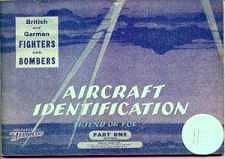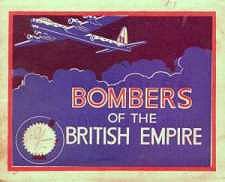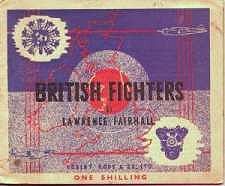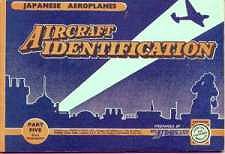| bc |
BIGGLES,
WW2 AND YOU
The BIGGLES QUIZ
Can you
answer these 100 questions?
Since I
first established the
Biggles and TV-related pages on the Collecting
Books and Magazines website back in 1997, it's
become apparent that two interests with large followings
are of course BIGGLES and Britain's great comedy series,
DAD'S ARMY. Many friends I've made over the past decades
are fans of both genres so I figured it was time that the
two were brought together here.
This page
is specifically tailored to encourage your participation.
It will of course revolve around Britain's home front
with eye-witness accounts and the like. If you're a fan
of W E Johns, 'Dad's Army 'or 'Goodnight Sweetheart', I
hope you can forward a contribution. What attracted you
to Biggles, Dad's Army, etc.? Are you old enough to
remember the Battle of Britain? Let me know via the guest book link at
the end of the page.
To start us off, here's an
eyewitness account, the first of many (I hope) from a
good friend who is a keen collector of Observer's books
and anything Sherlockian, GEOFF.
A
SCHOOLBOY'S MEMORIES FROM 1939
In 1939 we were living in south
east England, about 20 miles due south of London and
about 18 miles south east of Croydon Airport. This at the
time was the main base for the Imperial Airways airliners
that flew out to Europe and the Empire. I was ten, and
one Saturday afternoon our neighbour drove my father and
self over to Croydon Airport. I can recall to this day
the thrill of going into an observation area and watching
the arrival and departure of these wonderful pre-war
airliners.
Where we were living was under the flight path of many of
the flights from Europe and I can see myself standing in
the garden one 1939 summer’s evening watching
airplanes coming over to land at Croydon. My Father
turned to me and said that the pilots on the planes from
Germany were learning their way over to London for the
forthcoming war - and of course he was right.
In August 1939, Hitler invaded Poland and as can be
imagined these events were dramatic to a young boy. Our
Prime Minister, Neville Chamberlain, gave an ultimatum to
Hitler at the beginning of September, to get out of
Poland or else! What a nerve to give such an ultimatum to
a well armed Germany! I was on my cycle in our garden on
Sunday September 3, 1939 and I stopped what I was doing
to listen to Neville Chamberlain broadcast to the nation
at 11am. He said simply and briefly that no response had
been received to his ultimatum to Adolf Hitler to get out
of Poland and therefore a state of war existed between
our two nations. Drama indeed to a young lad and I
thought it all sounded quite exciting. In less than an
hour I was to change my mind.
At the start of September our newspapers had printed
horrific pictures of the war in Poland. These images were
of horse-drawn army equipment being used against the
German tanks.There were pictures of retreating Polish
civilians being bombed and machine gunned by the German
Luftwaffe. I found these reports gory and nightmarish. So
with all this at the back of my mind the air raid sirens
wailed on that Sunday morning, soon after the declaration
of war. I was terrified and had visions of hordes of
German planes coming over to finish us off. We rushed for
cover and dived under tables and beds, and hid in
cupboards. At this time the Sunday church services were
still in progress and congregations were sent home. After
two hours or so, the air raid sirens sounded the
‘all-clear’. It subsequently turned out to be
an anti-climax – a German reconnaissance plane had
been spotted over the English Channel and had been chased
off by a Spitfire. So we could breathe again.
After Germany had achieved their objectives in Poland,
they turned their attention to the ‘western
front’ and began the campaign to take France and the
Netherlands. While this was going on there was something
of a phoney war over here in Britain. However this did
not stop us observing the ‘blackout rules’. At
sunset every window in the country had to have an opaque
covering to prevent any electric light being seen from
the air. Street lights and station lights were extremely
dim so that in effect Britain was ‘blacked out’
in order that no help was given at all to the German
pilots in the way of navigation.
During the remainder of 1939 and up to early summer, 1940
there were only sporadic air-raids and we were lulled
into a false sense of security .However the news from the
other side of the Channel was bad and the German armies
were marching on towards the French ports from where we
thought they would launch an invasion of our country.
Little did we know of the forthcoming air battles and the
bombing blitz of London and other cities – and
little did old Adolf know of the pasting his Luftwaffe
airforce would receive from the Spitfires and Hurricanes,
flown not only by very young British pilots but
reinforced with brave pilots from all parts of the
Empire!
1940
and the BATTLE OF BRITAIN
Through May and early Summer
1940, Hitler was reluctant to invade Britain. He admired
the Brits and what he really wanted was for us to join
forces with him and destroy Russia. As we would have none
of that, he gave assent to the possible invasion of our
Country providing that the Luftwaffe gained air
supremacy. The battle for this vital air control or The
Battle of Britain, began on August 15, 1940.
In the summer of 1940 our factories were producing more
Spitfires and Hurricanes than we had pilots to fly them
despite volunteers from America , the Empire and pilots
who had escaped from German occupied countries of Europe.
At the height of the Battle of Britain in September 1940
I was just 11 years old. From our garden, 20 miles south
of London, we were able to view German bombers in huge
formations flying directly overhead on their way to the
heart of the city. There were dogfights as Spitfires and
Hurricanes flew in, breaking up the formations. I stood
in the garden watching the fights, some of them being
staged low overhead. These really were momentous days,
days that are still vividly etched in my memory.
One piece of strategy devised by Group Captain Douglas
Bader, the legless air ace, was as follows.
Before the German bombers and fighters crossed our
coastline, Bader marshalled his fighters to an altitude
above which the Germans would be flying. As the German
planes flew in, Bader’s planes would be waiting with
the sun behind them so that they would be difficult to
spot and could take the enemy unawares. This strategy was
very successful. The Spitfires and Hurricanes then dived
out of the sun on the tight German formations breaking
them up, shooting down bombers and fighters and generally
creating panic and fear in the German aircrews. You can
hear the latter drama in real live footage of radio
transmission recorded at the time, as German voices were
heard to scream "Achtung,achtung,
Shpeetfire,Shpeetfire !!"
And so the air-battles continued over southern England
through the Summer and early Autumn of 1940. Although the
Winter bombing blitz was to follow , the Spitfires and
Hurricanes had gained air supremacy in daylight hours,
the German appetite to invade our shores was waning, thus
giving us a much needed breathing space. Winston
Churchill, our Prime Minister during the war years, gave
this tribute to the brave Allied pilots ; "Never in
the field of human conflict was so much owed by so many
to so few." A fitting tribute indeed.
On September 1, a Hurricane
flown by Group Captain Trevor Bryant-Fenn came down at
Hawley Corner near Biggin Hill. At the time this was
thought to have been piloted by Brian Noble but recent
evidence indicates that the latter's Hurricane came down
in the Chelsfield area. Both pilots, fortunately, managed
to bale out. Brian Noble came down in Marley Lake, just
behind where we lived. While all this was going on we
still attended school and never had any time off,
although as soon as a plane came down we were off to
inspect it, oblivious to any unexploded bullets or bombs.
One German bomber came down on the school playing fields
and exploded on impact. We were all there after school
and the sight was gruesome - the crew hadn't managed to
bail out.
|
And now, the
BIGGLES
QUIZ! A Biggles Challenge from
JIM |
The quiz which follows is only
for serious fans of Biggles’ books. Questions can
come from any one of the completed novels or from the
selections of short stories. The exception is
“Biggles and the Deep Blue Sea” – for I do
not possess a copy of this book. There are also no
questions from the uncollected stories for the same
reason. However, that still gives me over 90 to play
with!
Each answer will be checked by referring to the relevant
book and page - a mixture of paperback and hardback
editions.
An email to me will bring a list of the answers and the
book references. Please allow a few days for me to
respond.
Good detecting.
Biggles Quiz 1
1. Who lived on the shores of Lake Jumu ?
2. Of which country is Mariana the princess ?
3. Which ship changes its name to Pauline ?
4. Eddie Ross first appears in Biggles’ Combined Operation – when does he crop up again ?
5. What is the name of Henri Ducoste’s sister ?
6. In which story does ground engineer Brogart appear ?
7. In which story do Biggles and his comrades fly in
Tarpon aircraft ?
8. Who comes from Smettleworth ?
9. In which story is there a shady firm called Sunnitours
?
10. Who lives at the Villa Vanda and what does he collect
?
11. Over which city does Biggles drop the propaganda
leaflets to win the contest with Wilkinson ?
12. Which of the comrades finds Mazeus’ lance ?
13. Who decides to call his aircraft the Willie Willie ?
14. What aeroplane does Biggles use in the South Seas ?
15. What is the name of Li-Chi’s bosun ?
16. Where did the Starry Crown end her days ?
17. Who shoots down a MiG from a Halifax ?
18. Why was paper spread on the water on the East Anglian
coast ?
19. Where did Swenson fall over the edge after Biggles
shot him ?
20. Who accompanies Adrian Mander into the desert ?
21. Who is Princess Lazu ?
22. To whom does Biggles give a Viking funeral ?
23. Who was called “cissy” at Cranwell ?
24. Who lives at Muskeg Bend, Eskimo Island ?
25. Who owns a boat called der Vespe ?
26. In which story does Biggles employ Chintoo as a cook
and interpreter ?
27. Which crook spends some of his time in the Icarian
Club ?
28. In which story do Biggles and his comrades come
across a castaway called Alf Robinson ?
29. How does the pilot Thea Hertz cause her plane to
crash ?
30. Whom does Biggles bump into in the Hotel Prinz Karl ?
31. Which pilot dives into the crocodile-filled Daly
River ?
32. Which man is a stooge inside the prisoner’s
compound in Christophe’s camp ?
33. In which story does Biggles employ Mishu, the Masai
warrior ?
34. Who lived at Rumkeg Haven ?
35. Which villain has eyes that “flashed with a
metallic sheen” and exerted a hypnotic power over
some people ?
36. What does Biggles find when he obeys Von
Zoyton’s directions and taps under the medical chest
?
37. What are the main animals in Castillon ?
38. Whose main occupation was reading thrillers and
boasted that he read one a day ?
39. In which book does Francisco Tristano decide to carry
out a vendetta-like vengeance ?
40. Who lives in Ringlesby Hall and has a problem with a
raven ?
41. What is found in the wreck of the aircraft on the
slopes of Ben MacDhui ?
42. What is the number of the U-boat in Biggles’s Second Case ?
43. In which book is Biggles promoted to Inspector ?
44. What was the name of the animals that used to visit
the watering hole at El Asile ?
45. What is the real name of the Professor in the World
War 1 stories ?
46. From which British port did Biggles, Algy and Dickpa
sail for New York en route to South America ?
47. What were the nationality of the allied troops hidden
near Sidi Arish that Biggles reported to von Faubourg ?
48. What was the name of the president’s daughter
that Algy falls for ?
49. What was the name of the tiger and leopard hunter
that played a part in Biggles’ early life ?
50. In which Spanish city did Biggles first encounter
Goudini ?
51. What was hidden inside Mr. Kindus’s tunny fish ?
52. Which one of the comrades does von Stalhein send a
postcard to ?
53. In whose air force does Lieutenant I’Nobo serve
?
54. In which book does Taffy Welsh disappear ?
55. What sort of jewels does Lord Langdon have stolen ?
56. In which book does Ram Singh help Biggles and Bertie
?
57. Who has an address at Chedcombe Manor ?
58. In which country does Petolski die on the ice ?
59. Where does Rex Larrymore land on a lake and discover
it is in fact blue moss ?
60. What is the name of the quisling Scandinavian who
welcomes the invading German air force ?
61. Who was shot in his Puss Moth near Mount Ruwenzori ?
62. Who is in command of the big R.A.F. depot at Khartoum
when Bertie lands there ?
63. In which book does Biggles explain to Bertie and
Ginger about trick shooting ?
64. Who is the air police’s expert on cattle ?
65. Who is Nerky and why has he been “blinding”
Biggles to all eternity ?
66. Which lady pilot owns a white three seater Falcon
that Ginger borrows ?
67. Who was Joseph Bawn who was executed in Port Royal ?
68. Whom does Bertie call “old boozer” and
“merry old toper” ?
69. Who disguises himself as a priest to help catch the
thief who stole the Rajah’s pearls ?
70. What does Bertie pretend to be collecting when he
lands on the Colonel’s island ?
71. In which story does the Owlet crash in Sudan ?
72. Which pub does Biggles have to visit when he joins
the crooks of London ?
73. Where do Biggles and his comrades find the yacht
Dryad from Amsterdam ?
74. Who was kidnapped from a lake in Kansas ?
75. Which pilot thinks he has found the city of Ophir ?
76. Who is a descendant of the Master of Tola ?
77. Whom does Biggles meet in the Adlon restaurant ?
78. What does Colonel Alfondari have in his luggage on
board the Merlin ?
79. On what estate does Mr. Lin Seng live ?
80. In which story does Bertie fall into a hole and use
burning heather to attract attention ?
81. Who flies Angus Mackail to 666 squadron ?
82. In which story is Ginger trapped in an underwater
cave by a mako ?
83. What is the name of the man who wants to add a
flamingo egg to his collection but ends up smashing it
when attacked by a fer de lance ?
84. Which former member of 666 squadron was in training
for the middleweight championship and living near
Blackfriars Ring ?
85. Which former member of 666 squadron ends up in the
Paradise Valley colony ?
86. In which story is law and order represented by a man
called Delaney ?
87. Who was Ginger’s instructor when he learned to
fly ?
88. In which story do both turnbuckles ‘come
loose’ on the Wanderer ?
89. In which story does the pilot Scrimshaw survive
several missions until he dies in combat ?
90. In which story do Biggles and Algy hide down a
chimney ?
91. What is the second name of the two brothers Nigel and
Peter ?
92. What is the number on the cowling of the Hurricane
that repeats the cowardly trick of the Sopwith Camel
J9982 ?
93. Which misspelled word makes Biggles suspicious about
missing ships ?
94. Why doesn’t Robin Stone, aged thirteen, go into
the field owned by Mr. Werner ?
95. What is the name of the air hostess on the Caravana
from Buenos Aires to Santiago ?
96. Which man breeds silver foxes on an island off the
Labrador coast ?
97. How does Ginger trap the ships at the island of Isla
Santina ?
98. What was in the tin box lashed between two motor
tyres that was picked up by Paulson’s Moth seaplane
?
99. In which city were Biggles and Ginger when they found
a rope inside a chimney pot ?
100. For which sort of sweet or candy does Wilkinson have
a passion ?
Please send in your
contributions!
Back to the Captain
W E Johns and Biggles page
Back to the
Collecting Books & Magazines INDEX page
|
|
bc |



